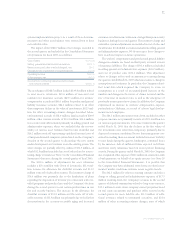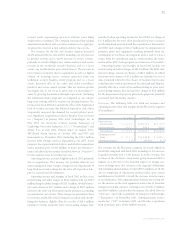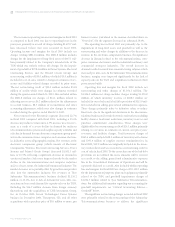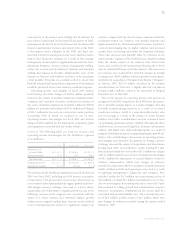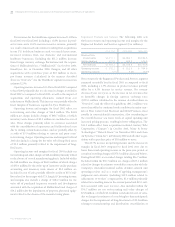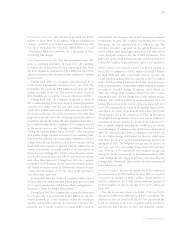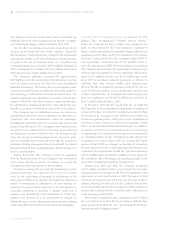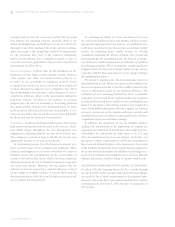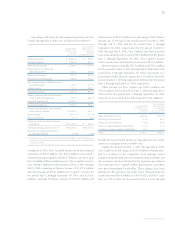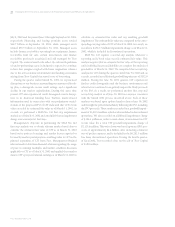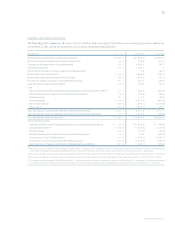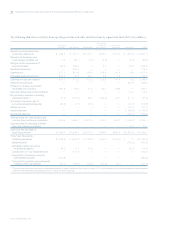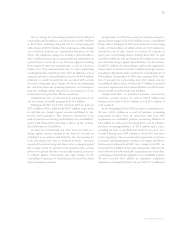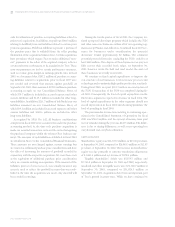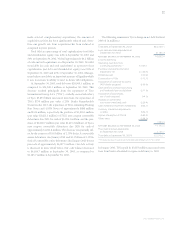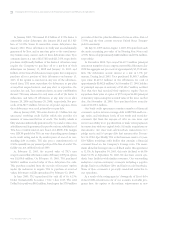ADT 2003 Annual Report Download - page 42
Download and view the complete annual report
Please find page 42 of the 2003 ADT annual report below. You can navigate through the pages in the report by either clicking on the pages listed below, or by using the keyword search tool below to find specific information within the annual report.
40
The difference in the tax rate from fiscal 2001 to fiscal 2002 was
primarily due to the non-recognition of tax benefits on signifi-
cant impairment charges, which occurred in fiscal 2002.
The tax effect on purchased in-process research and devel-
opment, restructuring and other credits (charges), charges for
the impairment of long-lived assets, charges for the impairment
of goodwill, net gain on the sale of businesses and investments,
net gain on the sale of common shares of a subsidiary and
accounting change was a benefit of $265.8 million during fiscal
2003, as compared to a benefit of $670.9 million during fiscal
2002 and a benefit of $68.6 million in fiscal 2001.
The valuation allowance increased by approximately
$249 million due to the uncertainty of the utilization of certain
non-U.S. deferred tax assets (see Note 10 to our Consolidated
Financial Statements). We believe that we will generate suffi-
cient future taxable income to realize the tax benefits related to
the remaining net deferred tax assets on our balance sheet. The
valuation allowance was calculated in accordance with the pro-
visions of SFAS No. 109 which requires a valuation allowance
be established or maintained when it is “more likely than not”
that all or a portion of deferred tax assets will not be realized.
The Company and its subsidiaries’ income tax returns are
periodically examined by various regulatory tax authorities. In
connection with such examinations, certain tax authorities,
including the Internal Revenue Service, have raised issues and
proposed tax deficiencies. The Company is reviewing the issues
raised by the tax authorities and is contesting certain proposed
tax deficiencies. Amounts related to these tax deficiencies and
other tax contingencies that management has assessed as prob-
able and estimable have been accrued through the income tax
provision. Further, management has reviewed with tax counsel
the issues raised by these taxing authorities and the adequacy of
these accrued amounts.
During fiscal 2003, the Company reached an agreement
with the Internal Revenue Service relating to the examination
of one of its subsidiary’s income tax returns. As a result, the
Company recorded a tax benefit of $22.4 million.
Except for earnings that are currently distributed, no addi-
tional provision has been made for U.S. or non-U.S. income
taxes on the undistributed earnings of subsidiaries or for
unrecognized deferred tax liabilities for temporary differences
related to investments in subsidiaries, as such earnings are
expected to be permanently reinvested, or the investments are
essentially permanent in duration. A liability could arise if
amounts were distributed by their subsidiaries or if their sub-
sidiaries were disposed. It is not practicable to estimate the
additional taxes related to the permanently reinvested earnings
or the basis differences related to investments in subsidiaries.
Cumulative Effect of Accounting Changes As discussed in “Off-
Balance Sheet Arrangements
—
Variable Interest Entities”
below, the Company has three synthetic lease programs uti-
lized, to some extent, by all of the Company’s segments to
finance capital expenditures for manufacturing machinery and
equipment and for ships used by Tyco Submarine Telecommu-
nications. During fiscal 2003, the Company adopted FIN 46
and, accordingly, restructured one of the synthetic leases to
meet the requirements of FIN 46 for operating lease accounting.
The Company has reclassified the remaining two leases as capi-
tal leases and consequently, recorded a cumulative effect adjust-
ment, a $75.1 million loss after-tax ($115.5 million pre-tax) in
fiscal 2003 in accordance with the provisions of FIN 46. In
addition, four joint ventures within Tyco Infrastructure
Services met the consolidation criteria set forth in FIN 46. As a
result of both the synthetic lease reclassifications and the joint
venture consolidations, the Company has increased property,
plant and equipment, net, by $433.8 million and total debt by
$562.2 million (effective July 1, 2003).
In December 1999, the SEC issued SAB 101, in which the
SEC expressed its views regarding the appropriate recognition of
revenue with respect to a variety of circumstances, some of which
are relevant to us. As required under SAB 101, we modified our
revenue recognition policies with respect to the installation of
electronic security systems (see “Revenue Recognition” within
Note 1 to our Consolidated Financial Statements). In addition,
in response to SAB 101, we undertook a review of our revenue
recognition practices and identified certain provisions included
in a limited number of sales arrangements that delayed the
recognition of revenue under SAB 101. During the fourth
quarter of fiscal 2001, we changed our method of accounting
for these items retroactive to the beginning of the fiscal year to
conform to the requirements of SAB 101. This was reported as
a $653.7 million after-tax ($1,005.6 million pre-tax) charge for
the cumulative effect of change in accounting principle in the
fiscal 2001 Consolidated Statement of Operations.
During fiscal 2003 and 2002, the Company recognized
$249.4 million and $294.2 million, respectively, of revenue that
had previously been included in the SAB 101 cumulative effect
adjustment recorded as of October 1, 2000. The impact of SAB
101 on net revenues in fiscal 2001 was a net decrease of $241.1
million, reflecting the deferral of $520.5 million of fiscal 2001
revenues, partially offset by the recognition of $279.4 million of
revenue that is included in the cumulative effect adjustment as
of the beginning of fiscal 2001.
We recorded a cumulative effect adjustment, a $29.7 million
loss, net of zero tax, in fiscal 2001 in accordance with the tran-
sition provisions of SFAS No. 133, “Accounting for Derivative
Instruments and Hedging Activities.”
TYCO INTERNATIONAL LTD.
Management’s Discussion and Analysis of Financial Condition and Results of Operations



